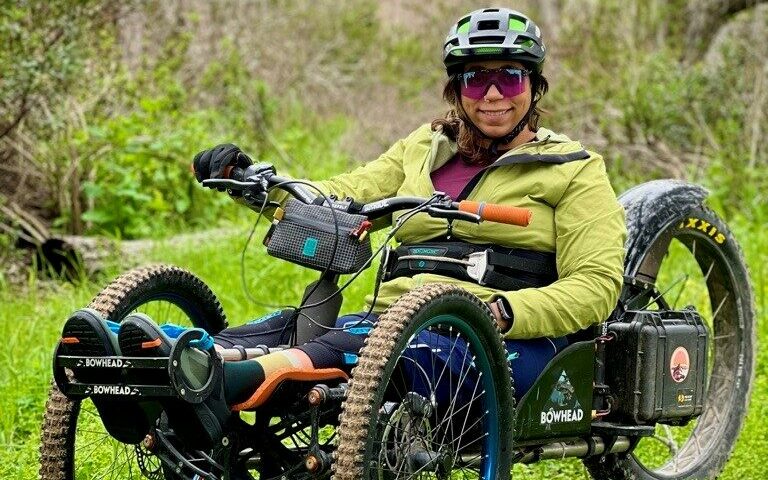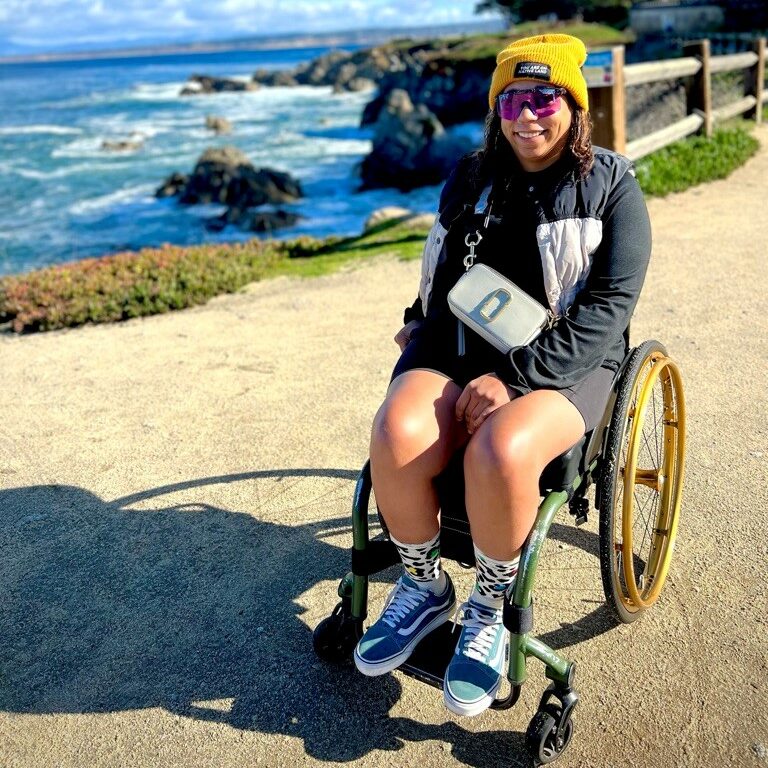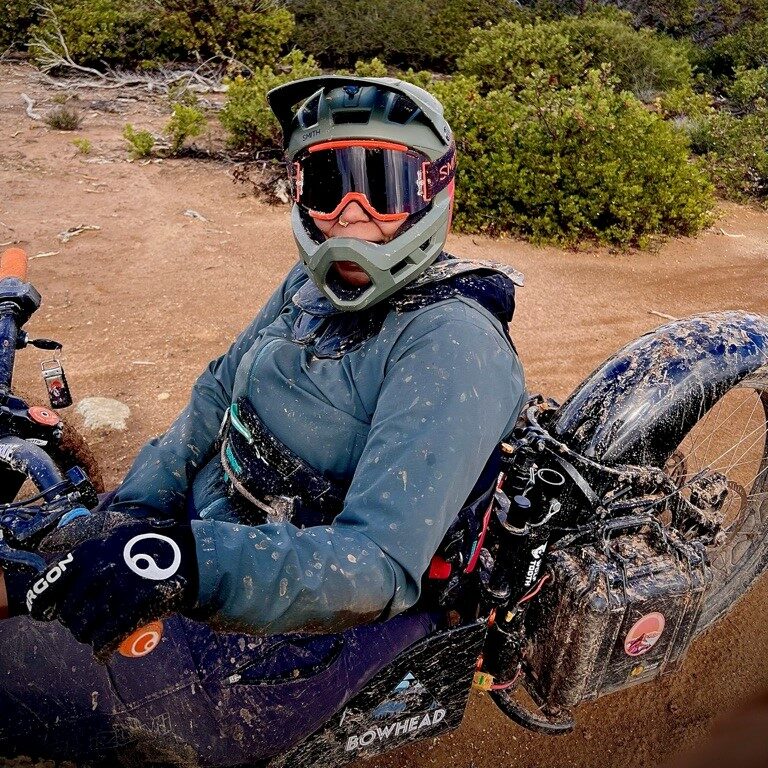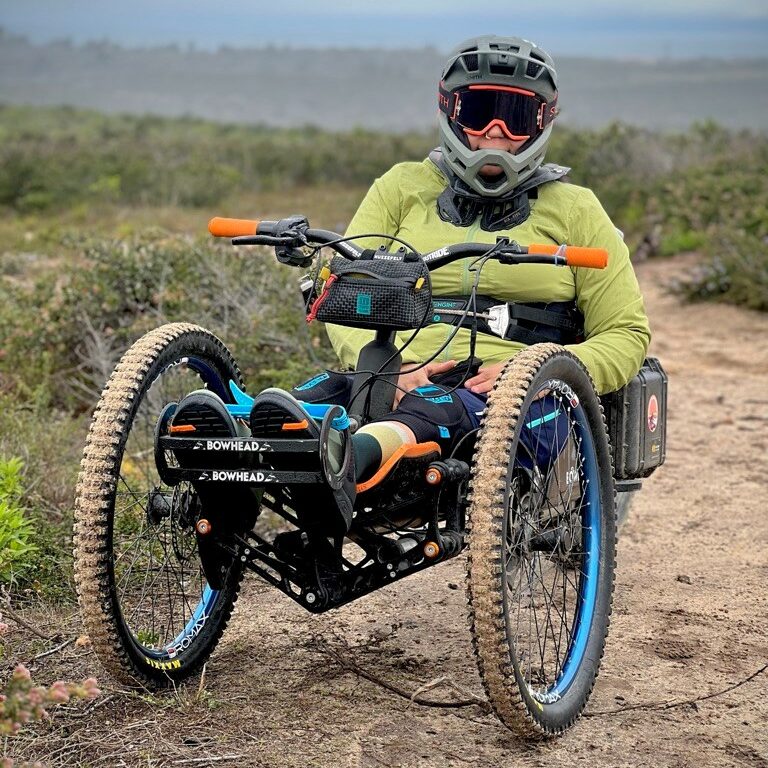Adaptive biker and disabled community advocate Annijke Wade talks neurogenic bladder management and inclusivity

For Annijke Wade,* mountain biking is more than a hobby, it’s an obsession – and it’s what she loves most in the world. A year and a half ago, Annijke rode on her favorite trail in Angel Fire, New Mexico – a route she’d completed more than sixty times – and lost control of her bike. The next thing she knew, she was on the ground and had lost feeling below her chest.
“The next thing I remember, I was just floating through the air,” Annijke recalls. “It was definitely the scariest moment of my life.”
Because Annijke was riding on mountain trails, she had to be extracted by the park’s biking patrol, which she recalls was incredibly painful.
“For the first three days it was really unclear what was happening, and it was hard to wrap my head around the severity of the accident,” she said.
After surgery, her clinician shared that she had sustained a T6/T7-level spinal cord injury and faced a long recovery ahead.
“There were a lot of emotions around that,” Annijke said. “One moment everything is going well, and then the next you’re in a very serious situation.”

But she also said there was hope in that diagnosis, because she knew what was going on and could begin to accept it. Once Annijke chose her rehabilitation center, she began setting her sights on what her life was going to look like, and she even began looking into adaptive biking options while still in the hospital. On top of this life-changing event, she had to begin managing her neurogenic bladder using intermittent catheters.
“I was excited because managing my own bladder meant that I would be less reliant on nursing staff and more independent,” she said.
She initially used a suprapubic catheter and SpeediCath® Compact Set Female or a leg drainage bag, which fit well with her active lifestyle and enabled her to continue pursuing activities she enjoys.
“A leg bag was a ticket to freedom for me,” she said. “I can recall an instance where I went to Montana fly fishing for a week, so I was on a boat all day long without access to my wheelchair, and I was able to manage my bladder with a leg bag. If I didn’t have that option, I wouldn’t have been able to be out there. It was an amazing experience, so having the leg bag allowed me to be independent, manage my bladder in a safe way, and get back to living life.”
In the early days of recovery, Annijke learned to track her input and output to monitor her fluid intake, which also helped her determine when to adjust her catheterization schedule accordingly.
“I figured out that certain drinks like coffee might go through me faster or increase my frequency of having to go to the bathroom,” she said. “In the long-term, it’s just better for you if you’re drinking enough water. I consume mostly water and have a cup of coffee in the morning or maybe a beer on the weekend, but I really try to stick to water, and that really helps.”

Annijke used an online journal to track her bladder routine, but eventually was able to self-monitor input and output. She’s also continued to catheterize hygienically on long bike rides, boating excursions, and skiing trips.
“On a bike ride I pack catheters and rubber gloves. Usually, I don’t use gloves when catheterizing, but because there’s so much dirt and dust around, I want to make sure I’m clean. I’ll also carry a bottle of hand sanitizer as well,” she said. “I’ll sanitize my hands and put my gloves on to make sure I’m not introducing anything into the area. I have a few extra layers of precaution in the outdoors.”
Annijke also uses hydrophilic, pre-lubricated catheters, which saves time, reduces catheterization steps, and makes bladder management in the outdoors much easier.
“Not having to worry about iodine and applying lube has been really beneficial,” she said. “It means I can carry fewer items and save space, but it also makes the process faster. All I have to do is open up the package, it’s pre-lubricated, and I don’t have those extra steps.”
Now, a year and a half post-injury, Annijke has been sharing her story of resilience and hope and is advancing access to mountain biking within both the BIPOC (Black, Indigenous, and People of Color) and disabled communities.
“As a Black and now disabled athlete, I don’t often see people who look like me when I’m doing activities like hiking or skiing,” Annijke said. “I didn’t really notice until I started mountain biking. I went to a couple clinics and looked around and thought, ‘I do look a little different,’ and I’m also a woman in these sports as well.”
Even before her injury, Annijke had started her diversity, equity, and inclusion advocacy work. During the Covid-19 pandemic, she had the opportunity to connect with other BIPOC mountain bikers to work on increasing representation and reducing barriers to entry in the sport. As part of that goal, Annijke worked on expanding diversity, equity, and inclusion initiatives within a mountain biking series.

“That’s when I stepped into the role of advocacy to create and maintain safe spaces so that when people who did look like me wanted to show up, they felt welcomed and supported,” she said.
After her injury, she maintained her focus on expanding mountain biking access to BIPOC communities, but now had a firsthand perspective of the barriers faced by the disabled community.
“As a person who has recently acquired a disability, I want to make sure that I’m listening to the community and understand the state of things and where I can plug in for advocacy,” she said. “A lot of the initiatives look at safety, coaching, trail access and design, and legitimizing the sport through competition.”
While using intermittent catheters can sometimes seem limiting at first, Annijke is confident that her bladder routine hasn’t held her back from pursuing the activities she’s passionate about.
“I’ve been really lucky to have some great solutions for managing my bladder, which has allowed me to be active,” Annijke said. “I wouldn’t say that anything is holding me back right now.”
Download a bladder diary to track input and output
For additional FREE bladder management resources, join Coloplast® Care today
*Annijke is a SpeediCath® catheter user who has received compensation from Coloplast to provide this information. Each person’s situation is unique, so your experience may not be the same. Talk to your healthcare provider about whether this product is right for you. Prior to use, refer to product labeling for complete product instructions for use, contraindications, warnings, precautions, and adverse events.
Information from Coloplast® Care is for educational purposes only. It is not intended to substitute for professional medical advice and should not be interpreted to contain treatment recommendations. You should rely on the healthcare professional who knows your individual history for personal medical advice and diagnosis.
SpeediCath® catheters are prescribed for use by pediatric patients (neonates to age 21) and adults who require bladder drainage due to chronic urine retention or post void residual volume (PVR). Before use, carefully read all of the instructions. Call your doctor if you think you have a UTI or can't pass the catheter into the bladder. For more information regarding risks, potential complications and product support, call Coloplast Corp. at 1-866-226-6362 and/or consult the company website at www.coloplast.us.